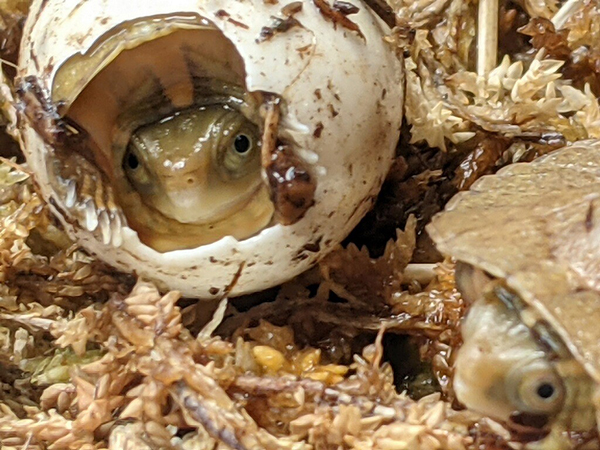News
Dalton State Successfully Hatches Sixth Endangered Turtle Species
09/22/21
.jpg) Knowing the endangered Beal’s eyed turtle prefers cooler climates and to be isolated from other species – and humans - Chris Manis took a chance.
Knowing the endangered Beal’s eyed turtle prefers cooler climates and to be isolated from other species – and humans - Chris Manis took a chance.
Manis, an assistant professor of biology and research associate at Dalton State College, moved the species out of their greenhouse home and into a safe outside enclosure last winter. Then he largely left them alone, except for what was needed for basic care, in hopes the species would begin reproducing.
It worked.
Dalton State’s Turtle Assurance Colony (TAC) is now home to three new Beal’s eyed turtle, Sacalia bealei, hatchlings. All three hatched this week after Manis found the eggs in June.
This makes the sixth endangered turtle Dalton State has successfully bred since TAC began in 2014.
“The male and female who bred are about 8 years old,” Manis said. “I had already decided I wanted to work with this species before we started the TAC. I thought they’d be a challenge and a little different, and therefore, interesting to work with. What I remember most from when I did an internship at the Tennessee Aquarium in graduate school is they had a colony of this species of turtles. So, I got to learn what a cool animal they are.”
The Beal’s eyed tends to be extremely shy compared to other species. They’re more nocturnal than most species of turtles, Manis said.
“You cannot be present all the time with this species,” he said. “Sometimes just your presence gives them reason to flee. In comparison, the tortoises we habituate don’t stress when they see us. We have animals that see us coming and equate us with food. But these see us coming and see us as predators and will run from us every time.”
But what really separates the species from other turtles is their physical appearance. They look like they have four eyes, two on the back of their neck, called ocelli. And, males drastically change color as they get older.
“They’re known for having eye-shaped markings on the back of their neck,” Manis said. “The markings are more pronounced in males. You can really see them pop. It’s really interesting. They’re so shy, though, it’s hard to show them to other people. Then the question becomes, ‘Why do they have those markings? What function do they serve?’ It may be that males, when they are trying to attract females, will get in front of the female and wave their head back and forth and side to side. But, the females also have these markings, just not as pronounced.”
As males mature, they change to a darker color, almost black skin, which becomes red and yellow around the legs.
“Because I’ve had these since they were young, I didn’t know the sex until they became adults,” Manis said. “I am fortunate I had male and a female. One day I looked at them, and it felt like overnight, I knew I had a male. In most turtle species you can tell sexes by tails, the curvature on the underside of an animal or by their nails. But in this one, the only difference is the coloring. The males become little peacocks while the females stay olive. The males’ irises also turn red.”
 Beal’s eyed turtles originated in mountainous regions of China. They were largely found in cool, rocky mountain streams, Manis said. They eat a predominantly carnivorous diet. The species is endangered because they are over-harvested to be sold as pets and for food and because they are losing their natural habitat.
Beal’s eyed turtles originated in mountainous regions of China. They were largely found in cool, rocky mountain streams, Manis said. They eat a predominantly carnivorous diet. The species is endangered because they are over-harvested to be sold as pets and for food and because they are losing their natural habitat.
Manis had kept this species in the greenhouse on campus for a couple of years, but since they prefer a more temperate climate than the greenhouse provides, he knew they’d have a better chance at reproducing if he moved them.
“I had one female lay an egg in the greenhouse, and it was good to know she could, but it was not viable,” he said. “I knew based on their natural habitat, she needed to be in cooler temperatures for part of the year. I took a chance. I read the literature that showed they could live in a mild-winter climate like we have. I put them in a safe enclosure outside for the winter and hoped it would do something to stimulate them. I checked on them periodically, and I knew the move was good for them. Around late June I began checking for eggs, and one day I found them. She had laid three, just a few days before I found them.
“I decided to leave the eggs in the enclosure outside instead of putting them in the incubator,” he said. “I wanted to see how they would develop naturally. Now I know this female is viable and produces good eggs that will hatch. The other female I have probably does too. So, this winter I’ll put her outside, too, and I will let the male move around and spend time with both females. Since I know she laid her eggs in June, I can go backwards to learn when fertilization took place. It takes about a month to shell those eggs in her body. That would put fertilization around late April or early May.”
Other species that have been bred in the TAC are the Forsten’s tortoise, Indotestudo forstenii; elongated tortoise, Indotestudo elongata; serrated hinge-back tortoise, Kinixys erosa; Southeast Asian box turtle, Cuora amboinensis; and the Home’s hingeback tortoises, Kinixys homeana.
Dalton State now participates in two programs geared toward saving endangered turtles, TAC and Saving Animals from Extinction (SAFE). With TAC it is not yet safe to reintroduce the species cared for into their natural habitat, while SAFE species are from the United States where there are regulations and sanctions in place to ensure the animal is not poached to extinction.
Dalton State is home to approximately 150 turtles across 15 different species. Students are responsible for husbandry duties, such as feeding the turtles, cleaning their cages and checking their shells and bodies regularly to ensure their health. This gives them hands-on experience handling and caring for animals that has led several students to obtain internships and jobs at aquariums and zoos.
